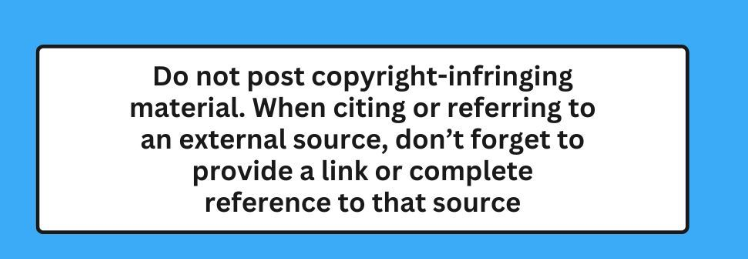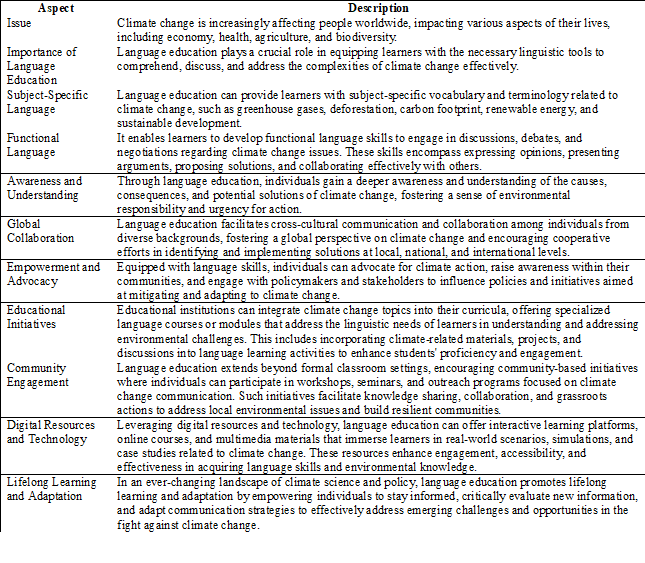





-
Activities and resources for teaching about Climate Change
-
@BRYANb8875625e5
Perfect! Really making sense. -
It was an amazing project. I try inclusion by giving each student with autism a shadow with no disability. The results were incredible. Know I'm teaching them how to code a FarmBot to apply technology in the lesson. In three weeks, they will be on vacation but I'm taking advantage of every second with them.
Best Bilim,
Mr. Bryan -
This page is amazing to learn about climate change with interactive games for the classroom.
https://subjecttoclimate.org/blog/10-climate-change-games-for-the-classroom
Interactive games can be a powerful tool in fostering a proactive mindset among students with or without disability regarding climate change. These games can simulate real-world environmental challenges, allowing students to experiment with sustainable practices and observe the consequences of their decisions in a risk-free environment.
By engaging students in scenarios that require critical thinking, problem-solving, and collaboration, interactive games can deepen their understanding of climate issues and inspire them to adopt eco-friendly behaviors. Like the sensory garden we made at our program. Moreover, these games can make learning about climate change fun and engaging, encouraging students to become active participants in the fight against global warming and instilling a sense of responsibility for the planet’s future.
I have hope in a new generation of students with climate change mindset-
-
Dear ma'am Ana . I have Searched some activities and resources for primary school students.
That may be beneficial for all teachers who teach science subject. Teaching climate change to primary school students can be both engaging and educational. Here are some activities and resources that can help:****Activities
Interactive Storytelling*Use stories and picture books that explain climate change in simple terms. Books like "The Lorax" by Dr. Seuss can be a great start. Climate Change Art Projects* Have students create posters or drawings that depict the effects of climate change and ways to help the environment. Nature Walks and Observations Take students on nature walks to observe local flora and fauna. Discuss how climate change might affect these plants and animals. Recycling Projects Organize a recycling drive or craft projects using recycled materials to teach the importance of reducing waste. Simple Science Experiments Conduct experiments that demonstrate the greenhouse effect, such as using jars to show how heat is trapped. Gardening Start a school garden to teach students about plant growth, the importance of green spaces, and how plants can help combat climate change. Climate Change Games Use educational games and simulations that teach about climate change and environmental conservation. Resources Books "The Lorax" by Dr. Seuss "The Magic School Bus and the Climate Challenge" by Joanna Cole "What is Climate Change?" by Gail Herman Websites NASA Climate Kids: Offers games, activities, and articles about climate change tailored for kids. National Geographic Kids: Provides articles, videos, and activities about the environment and climate change. EPA's A Student's Guide to Global Climate Change: Interactive website with information and activities. Videos YouTube Channels: Channels like SciShow Kids and National Geographic Kids have videos explaining climate change in a kid-friendly manner. Documentaries: Short documentaries like "Our Planet" (Netflix) have episodes suitable for children. Apps and Games Earth Rangers: An app that engages kids in missions to protect animals and the environment. WWF Together: An app that teaches kids about endangered species and conservation efforts. Lesson Plans Scholastic: Provides lesson plans and resources for teaching about the environment and climate change. Interactive Tools Climate Change Simulator: Simple online tools that allow students to see the impact of different actions on the climate. Carbon Footprint Calculators: Kid-friendly calculators that help students understand their own impact on the environment. Tips for Teaching Simplify Concepts: Use age-appropriate language and examples to explain complex concepts. Be Positive: Focus on solutions and actions that students can take to make a difference. These activities are really helpful for teachers in terms of resource management. -
@Mariam said in Activities and resources for teaching about Climate Change:
I have Searched some activities and resources for primary school students.
Dear Mariam, thank you for such a detailed selection of materials!
If you have taken this information from a website or other source, please be sure to include a link to that source in accordance with the forum rules and guidelines
https://elibrary-forum.sdpsg.101.com/topic/17/forum-rules-and-guidelines
-
@BRYANb8875625e5
You are soooo dedicated, Bryan. Chinese proverb comes to my mind regarding teaching activity "in order to give a glass of water to his/her student, a teacher has to have a pail of water" We collect spring water by working and growing with our students and colleagues.
Have a fascinating rest you as well to start with tank of water your next academic year!Best regards,
Bilim -
@Ana_moderator sure I Will .
-
This table outlines how language education can serve as a vital tool in addressing the challenges of climate change by providing learners with the necessary linguistic skills, knowledge, and resources to understand, communicate, and collaborate on solutions at local, national, and global levels.

-
These activities and resources aim to make learning about climate change engaging, interactive, and relevant to students' lives (see table)

-
Certainly! Here's a structured table providing information on how teaching about climate change can be engaging and impactful with the right activities and resources (see resum in table)
These approaches can make climate change education not only informative but also engaging and impactful for students of all ages.

-
These activities and resources aim to provide a well-rounded approach to understanding climate change, engaging students through discussion, hands-on projects, community involvement, simulation exercises, and artistic expression.

-
@Ana_moderator IAM sharing a link from Google that can help teachers to find more resourcesl material for their teaching techniques. I hope that could be helpful https://www.weareteachers.com/climate-change-activities/
-
Thank you so much, Bilim! Your kind words and the beautiful Chinese proverb are truly inspiring. It perfectly captures the essence of teaching, constantly learning and growing to provide our students with the best education possible.
I completely agree that our growth as educators is a collaborative effort, nurtured by our experiences with students and colleagues. Wishing you a restful and rejuvenating break as well, so we can all start the next academic year with a full tank of water, ready to inspire and educate.
Best,
Mr. Bryan -
@Mariam very interesting, have tried any of these activities?
-
@BRYANb8875625e5 said in Activities and resources for teaching about Climate Change:
It was an amazing project. I try inclusion by giving each student with autism a shadow with no disability. The results were incredible. Know I'm teaching them how to code a FarmBot to apply technology in the lesson. In three weeks, they will be on vacation but I'm taking advantage of every second with them.
this practice is really inspiring!
-
@Ana_moderator yes Ana I ve tried this one . Understand the difference between climate and weather . Kids understood it .
Also we did recycling in art period to make useful things. (Recycled .) -
Supporting students with dyslexia in the classroom can be facilitated using various Microsoft tools. Utilize immersive Reader in Microsoft Word to customize text settings, such as font style, size, and spacing, making reading more accessible. Incorporate PowerPoint for visual aids and diagrams, enhancing comprehension and organization of information. Encourage collaborative learning with Microsoft Teams, facilitating peer support and group projects while providing a platform for students to communicate their needs and preferences. Additionally, leverage OneNote for structured note-taking and organization, allowing students to create digital notebooks with multimedia elements. By integrating these Microsoft tools, educators can implement multisensory instruction, provide assistive technology support, and foster a supportive learning environment for students with dyslexia.
"Empowering students through engaging education, fostering environmental consciousness, and advancing scientific literacy. Committed to shaping future leaders in Life and Earth Sciences."
-
@Ana_moderator
Hello Anna,
Climate change is an important topic which according to me should be taught from the primary level itself because it is important to sensitize our your young learners about actions to be taken to protect our environment to prevent its impact globally. I normally teach this topic through ICT by integrating my students to AR and VR. I often use Nearpod platform. Students of diverse learning needs are involved in the teaching and learning process. Children viewed videos on the impacts and consequences due to climate change. They are asked to reflect about it. This platform also provides an assessment tool where evaluation is carried out at the end of the lesson. -
Hello from sunny Uzbekistan.
Once again I decided to please you with an interesting lesson: "PROBLEMS IN THE RELATIONSHIPS OF
BETWEEN MAN AND NATURE."
Mixed lesson (learning new material, consolidation, lesson-project)
Lesson objectives:- Educational - to familiarize students
with the objectives of the lesson, to show that ecological knowledge
is the basis of human interaction with
environment, rational use
natural resources; - Educational - to form the knowledge of ecology and nature preservation; 2) Educational - to familiarize students with the objectives of the lesson.
ecology and nature conservation; - Developmental - to develop academic and
intellectual skills; to develop the ability to work with
tabular material; develop logical
thinking, cognitive interests; to develop
the ability to correctly make reasonable conclusions.
Lesson objectives:
To familiarize with the consequences of environmental
problems.
- when familiarizing with environmental problems
to form knowledge about their causes
occurrence, consequences and possible
ways of elimination (prevention)
environmental problems;
-continue the formation of the ability to analyze;
-to contribute to the further development
critical, inventive and creative
thinking of students;
-facilitate the development of the ability to generalize and
highlight the main things, systematize the obtained
knowledge.
https://www.youtube.com/watch?v=vpf_GFGozaA
Attached please find video short from this lesson
Contacts:
Shakhnoza Khamrayeva
Sehriyo School, Tashkent
WhatsApp: +998881585511
hamraeva.s@gmail.com - Educational - to familiarize students